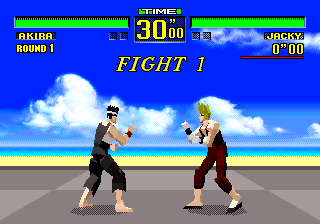Anamorphic widescreen
From Sega Retro
Prior to the release of the Xbox 360 in 2005, it was common to see video game consoles target what was then a standard in NTSC televisions - a 4:3 aspect ratio for displaying images. However, by the mid-2000s the television market had begun to favour the 16:9 "widescreen" aspect ratio, making televisions in the home more in-line with aspect ratios seen in movies.
While widescreen had been around in numerous forms for many years, most consoles producing digital signals were only capable of rendering a 4:3 image. However, safe in the knowledge that this resulting image could be stretched horizontally for 16:9 displays, many developers added support for anamorphic widescreen. Here, a 4:3 image is drawn in such a way that when stretched to 16:9, the proportions of the graphics would appear as intended, offering many of the advantages of widescreen displays without the need to physically render a larger image.
Anamorphic widescreen is not "true" widescreen, as each pixel is designed to be stretched (and so is not square). This typically means the image is blurrier as there is less information across the X axis, however on older televisions, particularly widescreen CRT displays, the artifacts would be less noticeable. With the advent of the HDMI standard, anamorphic widescreen is rarely seen in newer electronics, however remains a common feature for DVD movies.
Contents
Example
Virtua Fighter on the Sega 32X supports anamorphic widescreen:
| 4:3 mode on 4:3 display | 4:3 mode on 16:9 display |
|---|---|
| 16:9 mode on 4:3 display | 16:9 mode on 16:9 display |
When the game aspect ratio is matched with that of the television, Virtua Fighter looks as intended, otherwise Akira and Jacky are either too "thin" or too "fat". In this case, the benefits of 16:9 widescreen involve being able to see more of the playfield, however this comes at the expense of graphical fidelity. All four screenshots render internally at 320x224.
Sega games which support 16:9 widescreen
Several games for Sega systems support anamorphic widescreen, although unlike a more modern console such as the Wii, the feature was not made a priority due to the limited number of widescreen television users in the 1980s and 1990s. Also in most situations, widescreen support only affects the 3D portions of a game - 2D areas such as menus are usually fixed at 4:3, and so will be streched on a widescreen display.
Sega 32X
- Virtua Fighter (1993)
Sega Saturn
- Christmas NiGHTS into Dreams (1996)
- High Velocity: Mountain Racing Challenge (1995)
- Masters: Harukanaru Augusta 3 (1995)
- NiGHTS into Dreams (1996)
- Panzer Dragoon Zwei (1996)
- Pro Yakyuu Greatest Nine 97 (1997)
- Pro Yakyuu Greatest Nine 97 Make Miracle (1997)
- Pro Yakyuu Greatest Nine 98 (1998)
- Pro Yakyuu Greatest Nine 98 Summer Action (1998)
- Saturn Bomberman (1996)
- Touge King the Spirits 2 (1997)
- Waialae no Kiseki: Extra 36 Holes (1997)
- Zen Nihon Pro Wres Featuring Virtua (1997)
Sega Dreamcast
- Disney's Donald Duck Quack Attack (2000)
- F355 Challenge (1999)
- Giant Gram 2000: Zen Nihon Pro Wres 3 Eikou no Yuushatachi (2000)
- Giant Gram: Zen Nihon Pro Wres 2 in Nihon Budoukan (1999)
- Rayman 2: The Great Escape (2000)
- Sega Worldwide Soccer 2000 (1999)
- Sega Worldwide Soccer 2000: Euro Edition (2000)
- StarLancer (2000)
- Tokyo Xtreme Racer 2 (2000)
- Toy Commander (1999)
- Toy Racer (2000)
- TrickStyle (1999)
- UEFA Dream Soccer (2000)
- V-Rally 2: Expert Edition (2000)
- Wacky Races (2000)
Note: Anamorphic widescreen can be forced in more Dreamcast games by using Action Replay CDX cheat codes.

